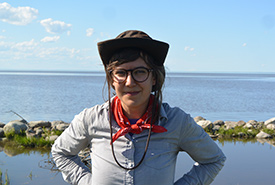The silence of the hillsides
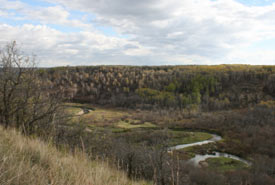
Fort Ellice, Riding Mountain (Photo by NCC)
For the past six months, I’ve worked as an assistant conservation biologist with the Nature Conservancy of Canada (NCC) in Riding Mountain Natural Area in western Manitoba. I found that a summer in the area challenged me to reconsider how I valued species and spaces.
In past summers, I have spent weeks paddling through the remote rivers of northern Ontario and Manitoba. While travelling, I often felt the nervousness that comes with spontaneous wildlife encounters, the discomfort of travel over unfriendly territory (like, seemingly endless thickets of hazelnut) and a sense of immersion in the natural world. In contrast to these places, some of NCC’s properties occupy a quarter-section, though in many areas, numerous quarter-sections and partial parcels have been sewn together to create larger blocks of conservation land.
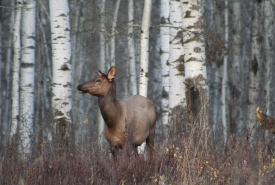
Cow elk, Riding Mountain Aspen Parkland, Manitoba (Photo by NCC)
On a recent windy autumn day, I was assessing the impact of cattle grazing on one of NCC’s properties when I heard a mating male elk bugle nearby. “How beautiful,” I thought, and carried on my way until I caught sight of the bull elk running through the grassland a hundred metres away. He ducked into a stand of trees, and we watched each other a bit warily until I turned back to my work.
A half-hour later, I entered a nearby cluster of trees, making a racket to let the elk know I was around. Unfortunately for me, the wind that day stole my voice, and minutes later a surprised elk ran full tilt through the woods no more than 30 metres away from me.
Heart in throat, I retreated back to the grassland, where at least I could be seen if not heard.
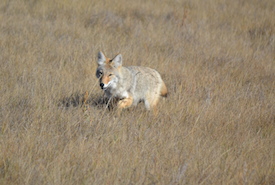
Coyote, Buffalo Valley (Photo by NCC)
Later, as I was on my way back to my truck, I almost stepped on a coyote perched perfectly still over its burrow! I was upwind, so the coyote was unaware of m presence; I stood back, enjoying such unusual proximity to a wild animal. Then a large snort in the bushes broke the spell and the coyote spotted me and ran off. I was left to wonder just who was snorting at us.
I’ll admit I was on edge for the remainder of that gusty day, wary of all the animals that could not hear me coming. The next morning, though, the sun rose calm and quiet to burn off the morning fog. A frost had settled onto the rose stems and their last clinging leaves, and I found myself sitting silently on a hilltop, watching the world reverse itself in a perfect reflection of trees in the small lake.
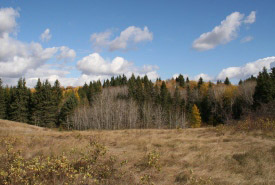
Riding Mountain Natural Area, Manitoba (Photo by NCC)
I reflected on just how much life a quarter-section of land can have. Once you’re in them, the small forest patches can seem as endless as larger tracts in places where no roads go. And the hillsides can offer such peace when you’re tucked away from the wind and watching waves roll through the prairie; as quiet as any I have known.
Working with NCC, I learned about the variety of species, the thickness of the brush and the powerful sense of calm found even in smaller, more settled places. Nature isn't far off — it's close by.
As someone who previously split most of their time between cities and lands accessible only by a hard day’s travel, I was inspired by the experiences I had on a few hundred acres tucked among the hayfields. It made me hope that perhaps humans and the rest of the natural world can co-mingle and maybe even coexist. Even with that spooky elk.

